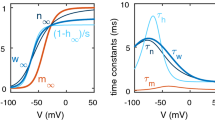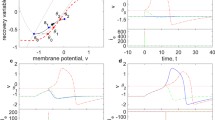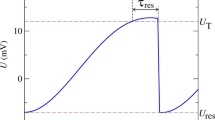Abstract
The Hodgkin-Huxley (HH) neuron is a nonlinear system with two stable states: A fixed point and a limit cycle. Both of them co-exist. The behavior of this neuron can be switched between these two equilibria, namely spiking and resting respectively, by using a perturbation method. The change from spiking to resting is named Spike Annihilation, and the transition from resting to spiking is named Spike Generation. Our intention is to determine if the HH neuron in 2D is controllable (i.e., if it can be driven from a quiescent state to a spiking state and vice versa). It turns out that the general system is unsolvable.1 In this paper, first of all,2 we analytically prove the existence of a brief current pulse, which, when delivered to the HH neuron during its repetitively firing state, annihilates its spikes. We also formally derive the characteristics of this brief current pulse. We then proceed to explore experimentally, by using numerical simulations, the properties of this pulse, namely the range of time when it can be inserted (the minimum phase and the maximum phase), its magnitude, and its duration. In addition, we study the solution of annihilating the spikes by using two successive stimuli, when the first is, of its own, unable to annihilate the neuron. Finally, we investigate the inverse problem of annihilation, namely the spike generation problem, when the neuron switches from resting to firing.
Similar content being viewed by others
References
Baer SM and Erneux T (1986). Singular Hopf bifurcation to relaxation oscillations. SIAM J Appl Math 46: 721–39
Best EN (1979). Null space in the Hodgkin-Huxley equations. Biophys J 27: 87–04
Carrington C, Gilby KL and McIntyre DC (2007). Effect of low frequency stimulation on amygdala kindled afterdischarge thresholds and seizure profile in Fast and Slow kindling rat strains. Epilepsia 48: 1604–613
Cooley J, Dodge F and Cohen H (1965). Digital computer solutions for excitable membrane models. J Cell Comp Physiol 66: 99–08
Devaney RL (2003). An Introduction to Chaotic Dynamical Systems, 2nd edn. Westview Press, Colorado
Gray JJ (2000). The Hilbert challange. Oxford University Press, Oxford
Guckenheimer J (1975). Isochrons and phaseless sets. J Math Biol 1: 259–73
Hilborn RC (2000). Chaos and nonlinear dynamics, 2nd edn. Oxford University Press, Oxford
Luders HO (ed) (2004) Deep brain stimulation and epilepsy. Martin Dunitz, an imprint of the Taylor and Francis Group, London
Mayberg HS, Lozano AM, Voon V, McNeely HE, Seminowicz D, Hamani C, Schwalb JM and Kennedy SH (2005). Deep brain stimulation for treatment-rezistant depresion. Neuron 45: 651–60
McIntyre DC, Carrington C, Gilby KL (2005) The ying-yang of low frequency sinewave stimulation in amygdalia kindled rats. American Epilespy Society Abstr
Osorio I, Frei MG, Wilkinson SB, Sunderam S, Bhavaraju NC, Graves N, Schaffner SF, Peters T, Johnson AM, DiTeresi CA, Ingram J, Nagaraddi V, Overman J, Kavalir MA, Turnbull M (2001) Seizure blockage with automated closed-loop electrical stimulation: a pilot study. Epilepsia 42
Guttman R, Lewis S and Rinzel J (1980). Control of repetitive firing in squid axon membrane as a model for a neurooscillator. J Physiol 305: 377–95
Rinzel J (1980). Numerical calculation of stable and unstable periodic solutions to the Hodgkin-Huxley equations. Math Biosci 49: 27–9
Teorell T (1971). A biophysical analysis of mechano-electrical transduction. In: Loeswenstein, WR (eds) Handbook of sensory physiology, vol 1, pp 291–39. Springer, Berlin
Wilson H (1999). Spikes decisions and actions: dynamical foundations of neuroscience. Oxford University Press, Oxford
Winfree AT (1974). Patterns of phase compromise in biological cycles. J Math Biol 1: 73–5
Winfree AT (1977). Phase control of neural pacemakers. Science 197: 761–63
Author information
Authors and Affiliations
Corresponding author
Additional information
1 This conclusion is a consequence of three well-known fundamental results, namely Hilbert 16th Problem, the Poincare-Bendixon Theorem and the Hopf Bifurcation Theorem.
2 We are extremely grateful to the feedback we received from the anonymous Referees to the initial version of the paper. Their comments significantly improved the quality of the current version. Thanks a lot!
Rights and permissions
About this article
Cite this article
Calitoiu, D., Oommen, B.J. & Nussbaum, D. Spikes annihilation in the Hodgkin-Huxley neuron. Biol Cybern 98, 239–257 (2008). https://doi.org/10.1007/s00422-007-0207-8
Received:
Accepted:
Published:
Issue Date:
DOI: https://doi.org/10.1007/s00422-007-0207-8




